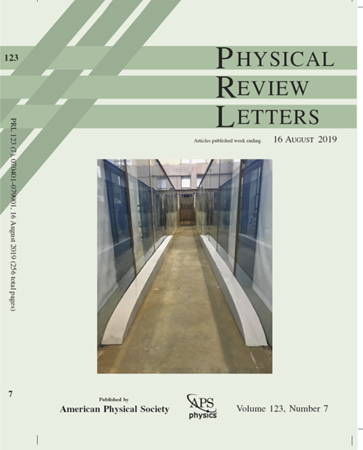Quantum Valley Hall Effect without Berry Curvature
IF 9
1区 物理与天体物理
Q1 PHYSICS, MULTIDISCIPLINARY
引用次数: 0
Abstract
The quantum valley Hall effect (QVHE) is characterized by the valley Chern number (VCN) in a way that one-dimensional (1D) chiral metallic states are guaranteed to appear at the domain walls (DW) between two domains with opposite VCN for a given valley. Although in the case of QVHE, the total Berry curvature (BC) of the system is zero, the BC distributed locally around each valley makes the VCN well defined as long as intervalley scattering is negligible. Here, we propose a new type of valley-dependent topological phenomenon that occurs when the BC is strictly zero at each momentum. Such zero Berry curvature (ZBC) QVHE is characterized by the valley Euler number (VEN) which is computed by integrating the Euler curvature around a given valley in two-dimensional (2D) systems with space-time inversion symmetry. 1D helical metallic states can be topologically protected at the DW between two domains with the opposite VENs when the DW configuration preserves either the mirror symmetry with respect to the DW or the combination of the DW space-time inversion and chiral symmetries. We establish the fundamental origin of ZBC QVHE. Also, by combining tight-binding model study and first-principles calculations, we propose stacked hexagonal bilayer lattices including无贝里曲率的量子谷霍尔效应
量子谷霍尔效应(QVHE)以谷切尔恩数(VCN)为特征,其方式是保证在给定谷切尔恩数相反的两个畴之间的畴壁(DW)上出现一维(1D)手性金属态。虽然在 QVHE 的情况下,系统的总贝里曲率(BC)为零,但只要间隔散射可以忽略不计,分布在每个谷周围的局部贝里曲率就能很好地定义 VCN。在这里,我们提出了一种新的依赖于山谷的拓扑现象,当 BC 在每个动量上严格为零时,这种现象就会出现。这种零贝里曲率(ZBC)QVHE 的特征是山谷欧拉数(VEN),它是通过对具有时空反转对称性的二维(2D)系统中给定山谷周围的欧拉曲率进行积分而计算得出的。当 DW 配置保留了相对于 DW 的镜像对称性或 DW 时空反转对称性和手性对称性的组合时,一维螺旋金属态可以在两个具有相反 VEN 的域之间的 DW 上得到拓扑保护。我们建立了 ZBC QVHE 的基本起源。同时,通过结合紧密结合模型研究和第一原理计算,我们提出了堆叠六边形双层晶格(包括 氛围-BX(𝑋=As, P)和大角度扭曲双层石墨烯)作为具有受 VEN 保护的稳健螺旋 DW 态的候选体系。
本文章由计算机程序翻译,如有差异,请以英文原文为准。
求助全文
约1分钟内获得全文
求助全文
来源期刊

Physical review letters
物理-物理:综合
CiteScore
16.50
自引率
7.00%
发文量
2673
审稿时长
2.2 months
期刊介绍:
Physical review letters(PRL)covers the full range of applied, fundamental, and interdisciplinary physics research topics:
General physics, including statistical and quantum mechanics and quantum information
Gravitation, astrophysics, and cosmology
Elementary particles and fields
Nuclear physics
Atomic, molecular, and optical physics
Nonlinear dynamics, fluid dynamics, and classical optics
Plasma and beam physics
Condensed matter and materials physics
Polymers, soft matter, biological, climate and interdisciplinary physics, including networks
 求助内容:
求助内容: 应助结果提醒方式:
应助结果提醒方式:


